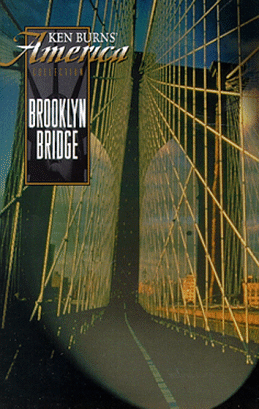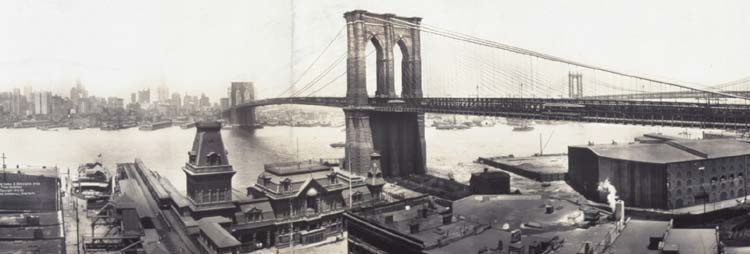Brooklyn Bridge
Documentary released in 1981 for PBS, color, 4:3 screen ratio, mono sound, 58 mins.
Production:
- Directed by Ken Burns
- Produced by WNET and Florentine Films
- Associate Producers Buddy Squires, Amy Stechler, Roger Sherman
- Cinematography by Ken Burns, Buddy Squires
- Written and edited by Amy Stechler
- Narrated by David McCullough, author of The Great Bridge (1983)
- Music composed by Jesse Carr
- Music directed by John Colby
- Consultants Lewis Mumford, Alan Trachtenberg, Jerome Liebling, Norton Juster, Barbara Millstein
- Voices of Paul Roebling (as Washington Roebling), Julie Harris (as Emily Roebling), Arthur Miller, Richard Pini, Austin Stevens, Kurt Vonnegut, Fred Sherry, Richard Rescia
Notes:
The Bridge was designed in the 1860s by John Roebling as a suspension bridge, like his Niagra Bridge of 1848, using steel cables made by the first wire rope factory in America. When Roebling was injured and died in 1869, his son Washington Roebling took over. The caisson foundations were built 1869-1872 by pneumatic excavation, causing workers to get the bends, or "caisson disease. The Gothic Revival twin towers were built 1870-1876. The four main cables were installed starting in 1876, with 6829 wires in each cable provided by the low bidder J. Lloyd Haigh. By 1877 it was discovered the wires were defective, but Roebling kept the work already done and added 250 extra wires per cable. The main span of 1595 feet was the longest in the world at that time. The last phase of construction was the roadway and railway 1878-1883, and the bridge officially opened May 24, 1883, connecting Manhattan with Brooklyn across the East River. Washington Roebling's wife Emily was the first passenger to cross the bridge, carrying a rooster as a symbol of victory. She had supervised much of the construction herself, after her husband suffered caisson disease in the first phase of construction. The second part of the documentary presents different interpretations of the bridge by artists, poets, novelists, singers, architects and historians.
"Not the land, not the garden, but the road, from Jefferson's own national turnpike to the latest superhighway, has expressed the essential way of American life." (Alan Trachtenberg, 1965)
Walt Whitman
Frank Sinatra
Lewis Mumford
David McCullough
Paul Goldberger
Hart Crane
Jack Unteracker
Arthur Miller
References:
- Liebling, Jerome, with essays by Anne Halley and Alan Trachtenberg. Jerome Liebling Photographs. Amherst: University of Massachusetts Press, 1982. 108 p.
- McCullough, David G. The Great Bridge. New York: Simon and Schuster, 1972. 636 p.
- Mumford, Lewis. Technics and Civilization. New York: Harcourt, Brace, 1934. 495 p.
- Trachtenberg, Alan. Brooklyn Bridge, Fact and Symbol. New York: Oxford University Press, 1965. 182 p.
- Brooklyn Museum. The Great East River Bridge, 1883-1983. New York : Abrams, 1983. 180 p.
Links:
History Department | Filmnotes | revised 9/20/00 by Schoenherr


